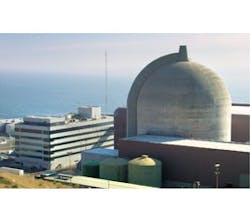A west coast nuclear plant is a two-unit Westinghouse pressurized water reactor (PWR) nuclear plant, with main condenser cooling provided by seawater. Seawater cooling makes the units very sensitive to ultra-trace condenser leaks and has necessitated the ongoing use of full-flow mixed bed condensate polishers to maintain the required levels of steam generator water purity. The plant uses organic ethanol amine (ETA) as the neutralizing amine in the steam water circuit to provide additional protection against flow-assisted corrosion and minimize iron transport to the recirculating steam generators. This has been the preferred practice for many pressurized water reactor plants of this type when condensate polishers are employed.
A Common Problem
Rapid kinetic impairment of the anion resin has been a common experience for plants running ETA chemistry with mixed-bed condensate polishers not having upstream cation resin beds. The kinetic degradation leads to increased sulfate concentrations in the steam generator. The exact mechanism by which the ETA-related fouling occurs is not well understood, and has only been managed by hot water rinsing of the anion resin and partial change out of the polisher beds with new anion resin. There has been no proven method for prevention of the ETA-related fouling.
Following a full system resin replacement in 2006, the plant also experienced the common symptoms of ETA-related problems, including reduced anion resin kinetics as measured by mass transfer coefficient (MTC), and increased sulfate concentration in steam generators.
Further investigations also discovered that the principal source of the additional sulfate in the steam generators was the extended rinse of ionic sulfate, and elevated effluent sulfate concentration coming from the mixed beds immediately following regenerations. The extended rinse and degraded bed effluent quality were a direct result of the reduced anion resin kinetics.
During the ensuing months, the plant continued to manage the sulfate problem by ongoing measurement of anion resin MTC, hot water rinsing of the anion resin, and occasional partial exchange of anion resin from the mixed beds with fresh anion resin. Although these efforts were somewhat successful, they placed extra burdens on plant staff. Without these efforts, MTC values would degrade and steam generator sulfate concentrations would become unacceptable.
Testing a New Solution
While the exact mechanism causing the degradation of anion kinetics remained unknown, the Dow Water and Process Solutions technical support team, working with the customer, continued efforts to gain understanding of the root cause issues. This ultimately led to an idea for a product change that would provide a more permanent solution to the kinetic degradation caused by the use of ETA in standalone mixed bed condensate polishers. In March 2010, a test bed of a new cation resin combined with AMBERJET 9000 OH anion resin, was installed at the plant. The plan for the test bed was to minimize cross-mixing of this test bed resin with all other mixed beds during operation, in order to develop an accurate data record of its anion kinetics over an extended period of time. The sulfate effluent performance of the bed also was monitored.
The sulfate rinse and effluent performance of the test bed remained ideal for almost two years following its installation, without any special efforts such as hot water rinsing or anion resin partial exchange. This was supported by regular periodic kinetic testing of the anion resin in the test bed. The kinetic performance of the test bed was better than the ongoing kinetic degradation that was seen in all other beds. By the end of the two-year test period, a slight decrease in the anion resin MTC was observed for the test bed. This reduction in anion MTC was due to the inevitable intermixing of the test bed resin with resin from the other mixed beds within the polishing system during resin regeneration and transfers.
Sustaining Condensate Polisher Operation
A test bed of the new cation resin—called DOWEX MONOSPHERE 1400PC—combined with AMBERJET 9000 OH anion resin was able to maintain stable, acceptable anion resin kinetics and sulfate effluent performance in a PWR mixed bed condensate polisher where ETA was used as the neutralizing amine. This was accomplished without the need for special hot water rinsing or top-up of resin in the test bed. The cation resin provides a new tool to help facilitate sustainable full-flow condensate polisher operation in PWR plants using ETA chemistry.
Download: Here


